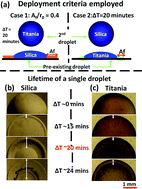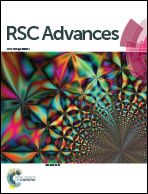Deployment strategy for controlled morphologies in sessile, mixed colloidal droplets
Abstract
Colloidal systems offer an effective medium to micro-engineer complex structures without involving sophisticated fabrication procedures. This article presents a deployment strategy of multiple droplets of different colloidal composition and utilizes the inherent capillary flow driven self assembly of nanoparticles to construct stacks of multiple materials on a given glass substrate. Here we used aqueous nano-crystalline titania and nano-amorphous silica solutions as the two materials. Initially, a pure nanotitania (nanosilica) droplet is deployed and allowed to dry partially. Subsequently, a second droplet of pure nanosilica (nanotitania) is deployed co-axially on the partially dried precipitate. The proposed deployment strategy allowed significant morphological differences when the deployment order of nanosilica and nanotitania were interchanged. Compositional analysis performed using EDX (Energy Dispersive X-ray spectroscopy) showed preferential deposition of nanosilica and nanotitania along the radial as well as the axial plane of the final deposit pattern. The underlying mechanism for such a phenomenon could be attributed to the contact line dynamics of a sessile double droplet. We also observe heteroaggregation of the nanosilica–nanotitania interaction along a narrow interface which resulted in nanotitania particles clustering into isolated islands embedded into a matrix of nanosilica particles. Overall, this work elucidates the evaporation driven dynamics of a mixed colloidal system which displays both macroscopic as well as microscopic phenomena. Such a system could be used to generate ordered arrays of functional materials with engineered micro to nano-scale properties.


 Please wait while we load your content...
Please wait while we load your content...